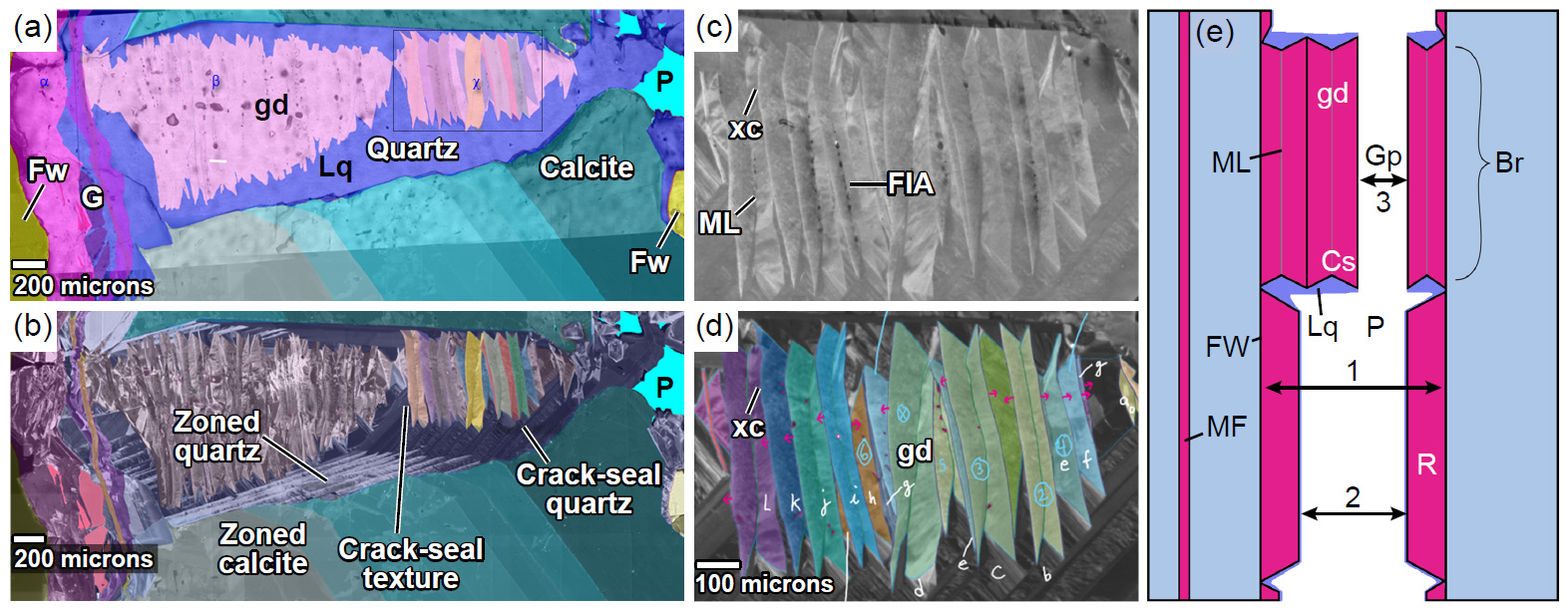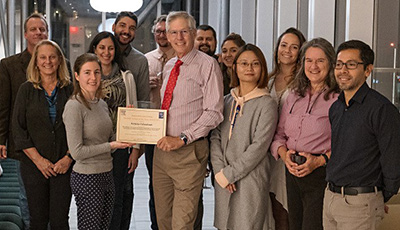Leaders in Structural Diagenesis
Structural diagenesis is a new perspective on the interaction of mechanical and chemical processes at high crustal levels in the Earth. Fracture and fault studies primarily rely on structural observations and interpretations based on mechanics, and rigorous structural observations and application of fracture mechanics continue to yield important insights. But, for understanding fractures and faults in the deep subsurface of sedimentary basins (1 to 10 km), structural geometry and mechanics by themselves provide an incomplete picture. In the presence of reactive fluids like those commonly found at greater depths in the Earth, chemical reactions are an essential consideration. Although sedimentary petrologists typically study chemical reactions that convert sediment to rock—diagenesis—they generally neglect fractures and faults. Structural geologists, on the other hand, typically do not receive intensive training in sedimentary petrology.
More than a decade ago, Bureau of Economic Geology researchers recognized that a key to unlocking scientific knowledge about postdepositional structural processes in sedimentary basins is research and systematic student training in principles of both structure and diagenesis. The Structural Diagenesis Initiative (SDI) was a major project funded by Bill Fisher in the first years of the Jackson School. SDI promotes a merger of disciplines and a new training paradigm in sedimentary geochemistry and structural geology. The Jackson School’s seed funding led to ongoing external support, and SDI continues as a community of researchers. SDI research yielded breakthroughs in fundamental fracture and fault problems, some of which were recognized by an award for “outstanding contributions in geosciences research” from the U.S. Department of Energy (DOE) Basic Energy Sciences (BES) program in 2004; many of these contributions are described in a recent Reviews of Geophysics paper.

Scanning -electron -microscope images of structural diagenetic textures within fractures. The linear feature in (a) and (b) is a cement deposit called a bridge formed during fracture opening. Such bridges, discovered in SDI research, allow researchers to measure key aspects of fractures, such as opening rate, that were previously inaccessible. Results can test predictive models and improve subsurface fracture diagnostics (Laubach et al.and others, 2019)
Among those leading the structural diagenesis movement is Bureau Senior Research Scientist Stephen Laubach. Laubach is principal investigator for a long-running DOE BES grant on predicting fracture porosity evolution in sandstone and is a leader of the industry-sponsored Fracture Research and Application Consortium (FRAC). The scope of these projects ranges from the fundamental to the intensely practical, but they share the theme of linked mechanical and chemical processes. In their different ways, both the BES project and FRAC seek to better understand how natural fractures grow in the Earth to improve resource production in oil and gas reservoirs and for other practical applications.
The Bureau’s structural diagenesis community, including Laubach, Peter Eichhubl, Julia Gale, András Fall, Esti Ukar, Sara Elliott, and Jon Olson, have been highly productive contributors to the scientific literature. The work has been recognized with various best paper awards and distinguished lecture tours.

Steve Laubach (center) presents the Journal of Structural Geology’s 2019 “Student Author of the Year Award” to Natalie Debenham for her paper The influence of a reverse-reactivated normal fault on natural fracture geometries and relative chronologies at Castle Cove, Otway Basin.
Much of the initiative’s success is attributable to mentored students and their research and publications. Current students include Rodrigo Correa, Natchanan “Mint” Doungkaew, Stephanie R. Forstner, Gabriel Gallardo Giozza, Bethany Rysak, Mahmood Shakiba, and Qiqi Wang. Notable recent student publications include papers by Almansour and others in SPE Reservoir Evaluation & Engineering, Callahan and others in JGR Solid Earth and in Geothermics, Denny and others in GSA Bulletin, Ramos and others in Geophysics and in Geophysical Journal International, Wang and others in Petroleum Geoscience, and Yue and others in SPE Drilling & Completion. And earlier students from the program are now leading the way at other institutions, like Peggy Rijken, named a distinguished alumna of The University of Texas at Austin Hildebrand Department of Petroleum and Geosystems Engineering (PGE), program chairperson for the 2019 Society of Petroleum Engineers (SPE) Annual Technical Conference and Exhibition, and working for Chevron; Kan Wu, professor at Texas A&M; Owen Callahan, now a postdoctoral fellow for the Bureau’s Center for Integrated Seismicity Research (CISR) Industrial Associates Program; and student and former Bureau researcher John Hooker, now at the Department of Geosciences at Penn State University.
More information about the scientific goals and accomplishments of the initiative can be found in these papers:
Laubach, S. E., Lander, R. H., Criscenti, L. J., Anovitz, L. M., and others, 2019, The role of chemistry in fracture pattern development and opportunities to advance interpretations of geological materials: Reviews of Geophysics, v. 57, no. 3, 1065–1111, doi:10.1029/2019RG000671. | view | blog post | BEG summary | view AGU Editor’s Vox | JSG press release
Laubach, S. E., Eichhubl, P., Hilgers, C., and Lander, R. H., 2010, Structural diagenesis: Journal of Structural Geology v. 32, no. 12, 1866–1872, doi:10.1016/j.jsg.2010.10.001. | view |
To learn more about FRAC and SDI, please contact Stephen Laubach.